Salvia africana
(S. africana caerulea)
|
![]()
Links to Other World of Salvia Pages:
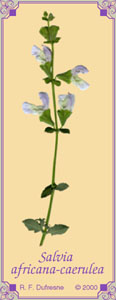 |
Blue African Sage Like most of the sages from South Africa, this species is xeric and likes Mediterranean conditions. Under ideal conditions, it can get up to four feet tall. It forms a dense cluster of stems at the base when it matures, which can make a nice refuge for pests in humid areas. Thinning out the stems on these sages is a good idea. These sages also work well as greenhouse plants if similar precautions are taken. It is nearly identical to S. dentata. The gray-green foliage is curly, and the flowering spikes are more open than the foliage. The calyxes are flared out, and the flowers are typically bicolored white and lavender. ©2000 by Richard F. Dufresne |
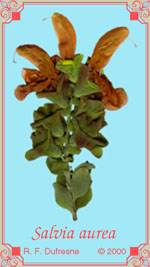 |
Golden African Sage This sage is one of the most unusual of the genus. The flower color is a distinct orange-brown, rare for most plant families. Additionally, it is large for most African sages. The flared calyx is also distinctive. This adaptive feature may be due to its need for pollination to attract sunbirds, the Old World equivalent of hummingbirds. Like its close relative, Salvia africana (S. africana caerulea), it is a xeric plant adapted to Mediterranean climates. It forms a dense cluster of stems at its base, making thinning for air drainage a necessity in subtropical areas. It can also get quite large under ideal situations, and can be kept as a conservatory or greenhouse subject over winter in colder climates. ©2000 by Richard F. Dufresne |
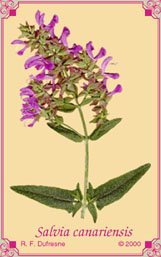 |
Canary Island Sage This majestic sage may be a link between Old and New World sages. The northwestern corner of Africa and New England were linked before the separation of the continents, and there may be a connection between Salvia lyrata and some of the basal rosette sages of northern Africa like S. taraxicifolia. S. canariensis is certainly distinct from most other sages; it is considered to be distantly related to the salvias of southwestern South Africa like S. aurea (S. africana lutea), S. dentata, S. muirii, and S. africana (S. africana caerulea). While difficult (for a sage) to be propagated by cuttings, it germinates readily from seed. Even grown as an annual in northern gardens, give it a lot of room. It will provide the garden with an interesting architecture of erect gray-green clove-scented foliage and stems covered with spun silver hairs. Blooming requires the planting of a mature specimen, and seems to occur in early to mid summer. ©2000 by Richard F. Dufresne |
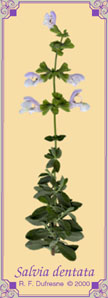 |
Toothed Sage Very similar to Salvia africana (S. africana caerulea), it differs mostly in details of leaf and calyx shape and in a more northerly distribution. Culture and use is almost identical. ©2000 by Richard F. Dufresne |
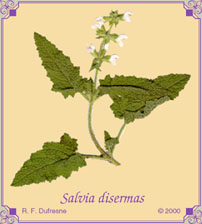 |
This distinctive sage belongs to a small sub-group found only in South Africa. It is a somewhat sprawling shrub with gray-green crinkled aromatic foliage and lose spikes of white flowers. The scent is a lot like that of the flower heads of clarey sage. As with most South African sages, it is xeric and benefits from Mediterranean conditions. It is easier to propagate from seed than from cuttings. ©2000 by Richard F. Dufresne |
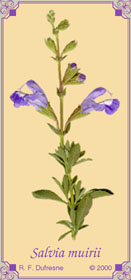 |
Sky Blue African Sage My favorite African sage is a plant that looks like a compact Salvia greggii in habit because of its neat simple green foliage. Like a lot of other South African sages, it forms numerous basal stems. In a pot, it grows almost as thick as moss. Liking heat and dryness, it can be difficult to keep in the dark and damp of winter. The large blue flowers in late spring and summer make the wait worthwhile.
There is a large marking emerging from the throat and spilling onto the
lower palate. As with S.
buchananii, the flowers are larger than the foliage. It has
possibilities as a rock garden plant and grow light subject.
©2000 by Richard F. Dufresne |
Links to Other World of Salvia Pages:
![]()
|
Salvia africana
(S. africana caerulea)
|